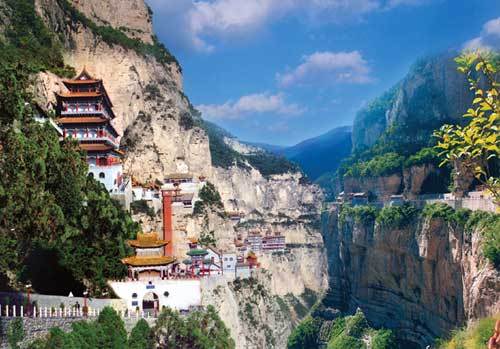2 perceptions of Mianshan Mountain
|
Mianshan Mountian in Shanxi Province is a tourist park filled with Buddhist and Taoist Temples and trails for minor hiking through some of the valleys. |
Having arrived in Beijing from the United States two months ago and tackled the city's major attractions, I found myself ready to escape the haze and congestion.
With only a few days to travel and a limited budget, Tibet was out, but a trip to the mountains, even if they were comparatively only mole hills, sounded like a cure for my city malaise.
Mianshan Mountain is quite the consolation prize, I thought. In addition to more than a thousand years of spiritual and political history, it boasted natural beauty, at least that's what some websites said.
|
Don't Miss: |
After 13 hours on a sold out train in which the tight spaces made me keep my knees locked and my luggage between my legs, please forgive me for expecting more than those three things. In some ways, Mianshan Mountain delivered, but halfway through my trip I wondered if the train-induced body aches were worth it.
Less is more
For nature lovers, Mianshan Mountain is like someone putting a bow in Mona Lisa's hair: the original beauty is undeniable, and the addition only detracts from that.
A ravine separates the part of Mianshan Mountain that hosts paved roads, restaurants, grocery stores and hotels from the part lacking the touch of human hands. With an appropriately placed zip line, a naturalist could escape modern convenience for the paradise of the wilderness in less than a minute. Without a convenient escape and having paid upfront for my 3-day hotel stay, I explored the domesticated side.
Log hand rails lined paths that cut through lush trees and sheer tannish-gray cliffs. The rails, though, weren't lumber. They were concrete molded into the shape of bark-covered wood.
Among plastic bottles discarded carelessly by tourists, freshly-painted and unworn statues of turtles, dogs and big cats stood in the currents of manmade waterfalls.
The choruses of birds and insects competed with a crackling PA system for the soundtrack to the day. An instrumental version of "Sounds of Silence" played so often I wished the song lived up to its title.
Each time I experienced one of these personal offenses, I looked across the ravine toward the untouched landscape of Mianshan Mountain and felt it taunting the part of me hoping to escape the artificial. In other words, I came wanting a Coca Cola and was served a Diet Rite. The aspartame atmospheres often forced me to rush through otherwise enjoyable views and created doubts about the authenticity of everything I saw, even the history within the area.
Looking beyond
The spiritual parts of Mianshan Mountain are often only a short walk from the constructed natural settings. Dozens of temples, many originally built more than 1,000 years ago, sit at the tops of steep staircases. Statues of Buddhist and Taoist masters share the mountain's view with the kitsch, which appear to have been standing since only the late 20th century.
About 100 feet from one temple stood a concrete cave full of artificial stalactites and an exit made to look like the mouth of a snake. At the exit, I saw several other fake rock structures. Instead of feeling pious, I felt part of a rejected set for an Indiana Jones movie.
With lactic acid burning my leg muscles, I walked to the next temple up hundreds of stairs and passed two 30-somethings glistening with sweat and gasping for air. At the top, two 60-somethings stared wide-eyed at the temples.
While I couldn't help but see the fake, I imagined the 60-somethings remembering stories they were told about this holy land as children and seeing the pilgrims from hundreds of years ago making the same trek, saying the same prayers.
Suddenly, the symbolism of the oneness of man and nature created by temples built into the mountainscape dominated the scene. The men, women and children willing to exhaust themselves so they could burn incense, make an offering and prostrate themselves before statues of Buddhist and Taoist masters assured that this experience was real.
After that, completing the trek to each of the temples made me feel part of the community. But I never dropped to my knees. I remained standing in fear that this action by a non-believer would be disrespectful. The invitations to worship were plentiful, however. At each, a man would encourage me — someone who is clearly a foreigner and likely not a practitioner of the religion — to kneel, make an offering and say a prayer.
Before I saw the 60-somethings at the top of the mountain, these men would have appeared as salesman trying to get a few extra RMB in their wooden offering boxes. I choose not to believe that, though. It would be, well, just too fake.
 0
0 








Go to Forum >>0 Comments